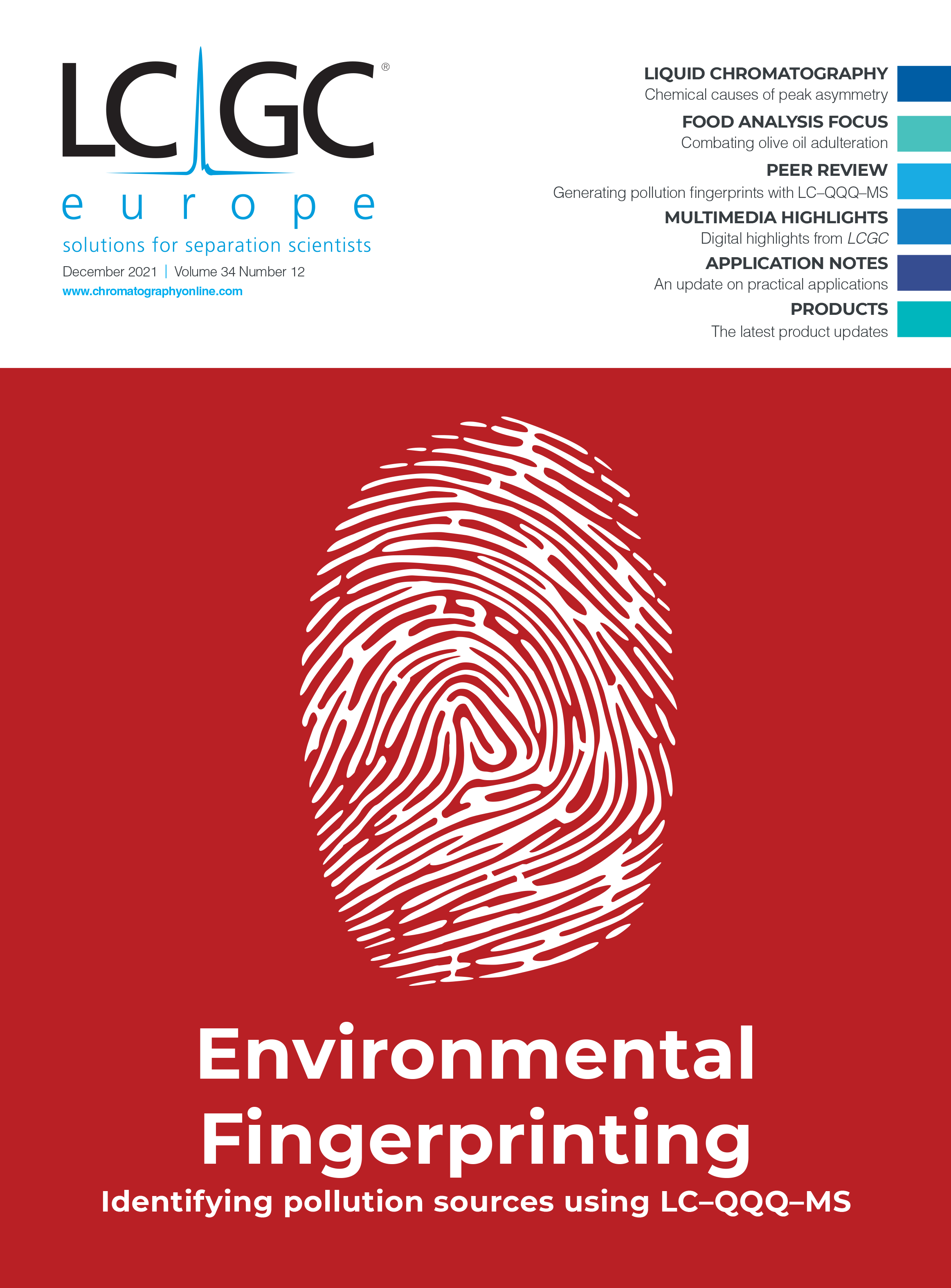Combating Olive Oil Fraud Using GC–IMS and FGC-Enose
The adulteration of high-quality foods is big business. Typical adulteration of olive oil involves the use of other types of oil, such as seed oils or pomace oils, the introduction of re-esterified oils, or the creation of mixtures with refined oils to create a lower quality product that can still be sold at a premium price. Fortunately, these processes can be easily detected using standard methods. However, fraudsters now seek more advanced methods using soft refined oils or oils with a tailored composition, making detection with existing procedures difficult. LCGC spoke to Michele Suman about novel screening and confirmatory analytical strategies he has investigated to regain the upper hand in the fight against olive oil adulteration.
Q. How common is olive oil adulteration and how large a problem is it in monetary terms?
A: Olive oils are basically grouped into three quality grades, namely “extra‑virgin olive oil” (EVOO), “virgin olive oil” (VOO), and “lampante olive oil” (LOO), on the basis of specific chemical and organoleptic criteria (1) from the Commission Delegated Regulation (EU) 2019/1604 of 27 September 2019 amending Regulation (EEC) No 2568/91 on the characteristics of olive oil and olive-residue oil and on the relevant methods of analysis (2).
Referring to the European Regulation No. 2568/91 and subsequent amendments, VOO must be obtained using solely mechanical or other physical means, under conditions that do not alter the product’s integrity. In contrast, the LOO category includes those oils that do not fulfil the minimum VOO quality criteria and, therefore, are not intended for direct human consumption. Finally, EVOO represents the top-quality grade because of its superior sensory attributes and the claimed health-promoting effects. EVOO is one of the most important and expensive edible oils, and is therefore also one of the most adulterated food commodities in the global market: limited production, higher price, and growing consumer demand represent an explicit fraud driver for EVOO.
The International Olive Council has clearly defined the limits of the specific chemical parameters able to protect EVOO against potential adulterations with other edible oils (3). Spain is the world’s largest producer of olive oil, with more than 40% of the world’s production originating from there, particularly from Andalusia. Another 20% comes from Italy, 18% from Tunisia, and approximately 12% from Greece. These four countries, together with Portugal, are also the largest exporters of olive oil.
Producing one litre of olive oil requires four to five kilos of olives on average; furthermore, processing methods also significantly affect olive oil yield.
In 2019, European import volume surpassed 11 million tonnes, at a value of ˇ1.6 billion, a decrease in comparison with previous years, caused by an overproduction in Europe that led to a significant drop in prices. In the long term, the European market for olive oil is expected to show stable growth of 3–5% over the next five years (4).
Q. What exactly are soft refined oils? And why do they represent a challenge to scientists to detect?
A: The term soft-deodorization refers to a deodorization process performed at a lower temperature with respect to the conventional process, for example, 100 °C instead of 180–200 °C. It basically consists of a vacuum steam distillation using nitrogen to strip out all the volatile compounds responsible for the undesirable odours. Deacidification is instead designed to remove the free fatty acids (FFA), which speed up oxidation processes and are involved in the development of rancid flavour. This is normally achieved through the addition of alkali, such as sodium hydroxide, to the oil; this results in the precipitation of the FFA as an insoluble soap dreg, subsequently removed by centrifugation and/or filtration. Since the use of lower temperatures does not seem to produce substantial compositional and structural modification in the bulk, the resulting soft‑refined olive oils (SROO) are best used to blend EVOO and create illicit mixtures no longer detectable by current methods (5). Typical fraud, such as adding other types of oils like seed oils or pomace oils, the presence of re-esterified oils, or the preparation of blends with refined oils, can be detected with standard methods. For this reason, fraudsters are now focused on developing more sophisticated adulterations, such as the use of soft refined oils, that would allow for the creation of blends that cannot be discovered with regular methods. Furthermore, another relevant issue is the misrepresentation of the geographical origin of the oils. While there are currently no recognized official methods for detecting these frauds, the literature suggests different approaches with promising results: gas chromatography–mass spectrometry (GC–MS), nuclear magnetic resonance (NMR), isotopic fingerprint studies, or liquid chromatography–mass spectrometry (LC–MS) coupled with chemometrics (6).
Q. You first approached the issue with a 2020 publication where a non-targeted high-resolution mass spectrometry (HRMS) method was used. Could you discuss your approach to selecting a method, and the positives and negatives of the selected approach?
A: We developed a non-targeted LC–HRMS study for the detection of new chemical markers able to identify the addition of soft deodorized and soft deacidified low-quality virgin or lampante olive oils to EVOO (7).
This approach has definite advantages in terms of effectiveness in detecting anomalies, even those not foreseen among those under examination, but it should be kept in mind that it entails high instrumental costs, technical staff of high competence, and is difficult to be directly implemented by an industrial control laboratory. The industry in this case is rather oriented to subcontract these analytical investigations to specialized external laboratories.
In this specific case, “in-house” soft refined oils were created and analyzed together with a group of pure EVOOs. In addition, different mixtures of pure EVOO and adulterated oils were included in the sample set. The markers selected through the study via robust data elaboration—12 molecules, seven of them were selected as discriminative in both the laboratories—were compared between two laboratories equipped with two different types of mass spectrometers, a quadrupole (Q)‑orbital trap and a quadrupole time-of-flight (QTOF), with the successful aim to assess the reproducibility of the proposed analytical approach.
Q. Your most recent publication took a slightly different approach to the issue and evaluated LC–MS, GC–ion mobility spectrometry (IMS), and flash gas chromatography electronic nose (FGC-Enose) for their suitability to detect olive oil fraud. What were your findings regarding their suitability?
A: In parallel to LC–MS studies, in the last couple of years we have explored the potentialities of two emerging headspace (HS)-based techniques, namely GC–IMS and FGC-Enose for the detection of EVOO blending with SROO (8). These two techniques offer rapid, minimal sample preparation, high‑throughput, and non-destructive solutions for quality and authenticity testing, which are highly sought by modern food industries. They provide global information about the volatile organic compound (VOC) profile in a short time. The methods exhibited both robustness and stability over time, giving promising results for screening purposes.
Additionally, the strategy of targeting the volatile profile is of interest because the main changes due to soft refining (especially for deodorization) are not expected to occur in the bulk fraction.
Very recently we also aimed our efforts into deepening the potential of the latest generation of multivariate statistical analysis: low-level data fusion of GC–IMS and the FGC-Enose datasets were performed (9). The merged unique fingerprints were submitted to partial least-squares discriminant analysis (PLS-DA) and the extrapolated most informative variables were used to build support vector machine (SVM) classifiers. The results of this PLS‑DA‑SVM strategy on the combination of datasets demonstrated that the discriminatory capability of the two merged GC-based techniques was remarkably improved compared to the individual ones, improving, for example, the sensitivity, which means that 20% or lower adulteration percentages detection could be achieved in the future.
Q. What were the main challenges developing this approach and how did you overcome them?
A: It was, of course, rather expensive to set up in the laboratory samples appropriately adulterated to “teach machines the frauds to recognize”, as well as collect data with several instrumental systems and multiple approaches, but perhaps the most complex part was the final stage of data processing.
To face the increasingly complex analytical challenges placed by fraudsters in olive oil adulteration and other areas of food analysis, laboratories need to recruit specialized staff with cross-skills in analytical chemistry and statistics, and learn to “merge” effectively complementary data from techniques capable of providing orthogonal information and therefore capable of enhancing both selective and discriminatory potentialities.
Q. What other projects are you working on?
A: We are currently working on both rapid screening and confirmatory methods to address the geographical origin of cereals, with a particular focus on wheat (10,11). For example, in Italy it is mandatory to declare the origin of wheat on the pasta label, according to a specific ministerial decree (12). Durum wheat (Triticum turgidum subsp. durum) is in fact the preferred raw material for the production of pasta due to its technological and nutritional properties, and the declaration of its geographical origin, sometimes claimed on pasta labels, represents an added value to the commodity.
References
- L. Conte, A. Bendini, E. Valli, P. Lucci, S. Moret, A. Maquet, F. Lacoste, P. Brereton, D.L. García-González, W. Moreda, and T. Gallina Toschi, Trends Food Sci. Technol. 105, 483–493 (2020).
- Official Journal of the European Union, n. L250, p. 14, 2019.
- IOC, COI/T.15/NC No 3/Rev. 14 - Trade standard applying to Olive Oils and Olive-Pomace Oils (International olive council, COI, Madrid, Spain, 2019).
- https://www.cbi.eu/market-information/processed-fruit-vegetables-edible-nuts/olive-oil/market-potential (accessed 15 Nov. 2021).
- C. Vaisali, S. Charanyaa, P.D. Belur, and I. Regupathi, Int. J. Food Sci. Technol. 50, 13–23 (2015).
- K. Katerinopoulou, A. Kontogeorgos, C.E. Salmas, A. Patakas, and A. Ladavos, Foods 9(4), 489 (2020).
- D. Cavanna, K. Hurkova, Z. Džuman, A. Serani, M. Serani, C. Dall’Asta, M. Tomaniova, J. Hajslova, and M. Suman, ACS Omega 5(38), 24169–24178 (2020).
- T. Damiani, D. Cavanna, A. Serani, C. Dall’Asta, and M. Suman, Microchemical Journal 159, 1–8 (2020).
- A. Tata, A. Massaro, T. Damiani, R. Piro, C. Dall’Asta, and M. Suman, Food Control 133, 108645 (2021).
- A. De Girolamo, M. Cortese, S. Cervelleri, V. Lippolis, M. Pascale, A.F. Logrieco, and M. Suman, Foods 8, 450–464 (2019).
- D. Cavanna, C. Loffi, C. Dall’Asta, and M. Suman, Food Chemistry 317, 126366 (2020).
- Italian Ministerial Decree of 26 July 2017, published in the Italian Official Bulletin n. 191 - 17 August 2017.

Michele Suman is Food Safety and Authenticity Research Manager at Barilla Spa. Since 2003, he has worked in an international context with public and private research centres/organizations on research projects within the field of food chemistry, food safety-quality-authenticity, food contact materials, sensing, and mass spectrometry applications. He is also Adjunct Professor of AgriFood Authenticity at Catholic University of Milan-Piacenza. He is the Chair of the Italian National Normative Organization (UNI) Food Authenticity Working Group, a member of the working groups for Biotoxins‑Processing Contaminants-Food Authenticity in European Committee for Standardization (CEN), and Chair of the ILSI Food ContaminantsTask Force. His scientific production is documented by 160 contributions at conferences and 112 papers.








